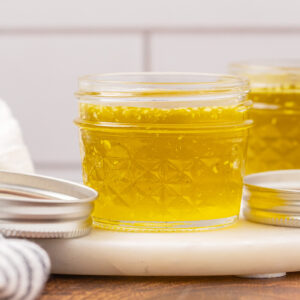
Herbal Salve Recipe for Dry Skin
Make this herbal salve recipe to rescue your skin. It combines natural beeswax, oil, and herbal support for the best healing against dry, flaky skin.
Equipment
- Crock Pot Or double boiler
- Strainer
- Storage Containers I like using these metal salve tins, but glass jars work, too. Just make sure you don’t use plastic containers, which are not appropriate for essential oils.
Ingredients
- 16 Ounces Extra Virgin Olive Oil Or Sweet Almond, Argan, or Coconut OIl.
- 1.8 Ounces Beeswax Granules Organic beeswax pellets are best for cosmetic use and easy to measure accurately. You can use a full two oz of beeswax for a firmer salve.
- 1/2 Cup Peppermint Dried
- 1/4 Cup Calendula Dried
- 1/4 Cup Plantain Dried
- 1/4 Cup Chamomile Dried
- 3 Capsules Vitamin E Oil
- 30-40 Drops Peppermint Essential Oil Optional
Instructions
- Add dried herbs and olive oil to your crockpot or pot and turn on low. If using a pot on the stove or if your crockpot runs hot, be careful that your herbs don't burn. Burned herbs = stinky salve! Ick! Let the herbs simmer on very low heat overnight or all day (about 12 hours.)
- At the end of the day, strain out the herbs using a colander or strainer, and toss the spent plant material in your compost pail.
- Put the oil back into the crockpot or pot.
- Add beeswax granules and essential oil to the oil in the crockpot.
- Pierce the capsules of vitamin E and add the contents as well.
- Stir all the oils together over low heat until the beeswax melts.
- Pour the oil and beeswax mixture into the containers of your choice and let cool. Pro-Tip: If you wait too long to pour the salve that has hardened, gently warm it again and then pour. It is also easier to clean out your pot when the oils are still warm before they have hardened onto the pot.
- Store in a cool, dark place to preserve the healing properties of your herbs.
Notes
- Carrier Oils – When making your own salves, use a combination of oils. Carrier or base oils I like to use include olive, sweet almond, argan, or coconut oil. These gentle oils provide healthy moisture for your skin. Pro tip: Never add water to your salves. Water will harbor bacteria and reduce the shelf life of your salve, so steer clear of salve recipes that call for it.
- Infusing Carrier Oils – Making an herb-infused oil like a DIY calendula oil adds properties to your salve that soothe and heal the skin. In this herbal salve recipe, I use herbs, including peppermint, calendula, plantain, and chamomile. All of these herbs contain oils that support the body’s response to irritated skin and anti-inflammatory properties (See more about this in the ingredients list.)
- Beeswax – Choose a quality beeswax and make sure that it is pure. Lower quality beeswax can have paraffin added, and I avoid using petroleum-based products when possible. Beeswax keeps the infused oils in and any outside irritants out. It also provides a thick consistency that stabilizes the oils so they don’t melt into a soupy mess.
- Vitamin E – Don’t skip this ingredient! Vitamin E is critical to boosting the antioxidant properties of your salve (Source), and also works as a natural preservative, keeping your salve fresh longer.
- Essential Oils – I recommend using a reputable company to source your essential oils. Do your own research and educate yourself on essential oil safety.
Tried this recipe?Let us know how it was!